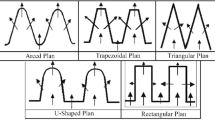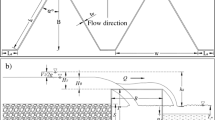Abstract
Flood discharge from dam reservoir is of utmost importance which is accomplished using weirs. The labyrinth weirs are suitable for narrow valleys as well as large floods. Labyrinth weirs have large flow passage length and consequently, high efficiency in discharging the incoming flood to the dam reservoirs. In the present study, by developing models and performing experimental tests, solutions were presented to improve the discharge coefficient and efficiency of the rectangular and trapezoidal labyrinth weirs. In other words, instead of using uniform and regular congresses in the rectangular and trapezoidal labyrinth weirs, unequal and irregular congresses were used, respectively, to increase the discharge coefficient of these types of weirs. The rectangular and trapezoidal labyrinth weirs each included 5 samples of the first type (A, D) and 5 samples of the second type (B, E) so that in the first and second types, the largest length of the congress occurred in the middle and side of the weir, respectively. Upon establishment of the mentioned models in the laboratory, different discharges were passed over the models and the flow characteristics were measured and recorded at different points, and then the discharge coefficient of the mentioned models was obtained. The solutions presented in the present study increased the discharge coefficient and consequently, the efficiency of the rectangular and trapezoidal labyrinth weirs. By using unequal and irregular congresses in the rectangular and trapezoidal labyrinth weirs instead of using equal congresses, the discharge coefficient improved on average by 40.7 and 35.3 percent, respectively.








Similar content being viewed by others
Availability of data and materials
The authors certify the data and materials contained in the manuscript.
References
Ahmad F, Hussain A, Ansari MA (2023) Development of ANN model for the prediction of discharge coefficient of an arced labyrinth side weir. Model Earth Syst Environ 9(2):1835–1842
Aydin MC, Ulu AE (2023) Numerical investigation of labyrinth-shaft weir. Appl Water Sci 13(4):89
Azamathulla HM, Haghiabi AH, Parsaie A (2016) Prediction of side weir discharge coefficient by support vector machine technique. Water Sci Technol Water Supply 16(4):1002–1016
Azimi AH, Hakim SS (2019) Hydraulics of flow over rectangular labyrinth weirs. Irrig Sci 37(2):183–193
Ben Said M, Ouamane A (2022) Performance of rectangular labyrinth weir–an experimental and numerical study. Water Supply 22(4):3628–3644
Ben Said M, Hafnaoui MA, Madi M (2023) Numerical analysis of the influence of approach flow conditions on the efficiency of labyrinth weir. Model Earth Syst Environ 9(1):41–51
Bilhan O, Emiroglu ME, Miller CJ, Ulas M (2018) The evaluation of the effect of nappe breakers on the discharge capacity of trapezoidal labyrinth weirs by ELM and SVR approaches. Flow Meas Instrum 64:71–82
Borghei SM, Nekooie MA, Sadeghian H, Ghazizadeh MRJ (2013) Triangular labyrinth side weirs with one and two cycles. In: Proceedings of the Institution of Civil Engineers-Water Management, vol 166, no. 1, Thomas Telford Ltd, pp 27–42
Carrillo JM, Matos J, Lopes R (2020) Numerical modeling of free and submerged labyrinth weir flow for a large sidewall angle. Environ Fluid Mech 20(2):357–374
Derakhshanifard M, Heidarnejad M, Masjedi A, Bordbar A, Egdernezhad A (2023) Experimental study of effect of creating an additional cycle along the lateral crest of the labyrinth weirs. Flow Meas Instrum 90:102306. https://doi.org/10.1016/j.flowmeasinst.2023.102306
Emami H, Emami S, Parsa J (2022) A Walnut optimization algorithm applied to discharge coefficient prediction on labyrinth weirs. Soft Comput 26(22):12197–12215
Ghaderi A, Daneshfaraz R, Abbasi S, Abraham J (2020) Numerical analysis of the hydraulic characteristics of modified labyrinth weirs. Int J Energy Water Resour 4:425–436
Haddadi H, Rahimpour M (2012) A discharge coefficient for a trapezoidal broad-crested side weir in subcritical flow. Flow Meas Instrum 26:63–67
Haghiabi AH, Nou MRG, Parsaie A (2022) The energy dissipation of flow over the labyrinth weirs. Alex Eng J 61(5):3729–3733
Idrees AK, Al-Ameri R (2023a) Investigating a new approach to enhance the discharge capacity of labyrinth weirs. J Hydroinf 25(2):300–317
Idrees AK, Al-Ameri R (2023b) Investigation of flow characteristics and energy dissipation over new shape of the trapezoidal labyrinth weirs. Flow Meas Instrum 89:102276
Khode BV, Tembhurkar AR, Porey PD, Ingle RN (2011) Determination of crest coefficient for flow over trapezoidal labyrinth weir. World Appl Sci J 12(3):324–329
Mirnaseri M, Emadi A (2013) Hydraulic performance of combined flow rectangular labyrinth weir-gate. Middle East J Sci Res 18(9):1335–1342
Monjezi R, Heidarnejad M, Masjedi A, Purmohammadi MH, Kamanbedast A (2018) Laboratory investigation of the discharge coefficient of flow in arced labyrinth weirs with triangular plans. Flow Meas Instrum 64:64–70
Noroozi B, Bazargan J, Safarzadeh A (2021) Introducing the T-shaped weir: a new nonlinear weir. Water Supply 21(7):3772–3789
Norouzi R, Daneshfaraz R, Ghaderi A (2019) Investigation of discharge coefficient of trapezoidal labyrinth weirs using artificial neural networks and support vector machines. Appl Water Sci 9(7):1–10
Ohadi S, Jafari-Asl J (2021) Multi-objective reliability-based optimization for design of trapezoidal labyrinth weirs. Flow Meas Instrum 77:101787
Parvaneh A, Borghei SM, Jalili Ghazizadeh MR (2012) Hydraulic performance of asymmetric labyrinth side weirs located on a straight channel. J Irrig Evac Eng 138(8):766–772
Roushangar K, Alami MT, Shiri J, Asl MM (2018) Determining discharge coefficient of labyrinth and arced labyrinth weirs using support vector machine. Hydrol Res 49(3):924–938
Safarrazavi Zadeh M, Esmaeili Varaki M, Biabani R (2021) Experimental study on flow over sinusoidal and semicircular labyrinth weirs. ISH J Hydraul Eng 27(sup1):304–313
Selim T, Hamed AK, Elkiki M, Eltarabily MG (2023) Numerical investigation of flow characteristics and energy dissipation over piano key and trapezoidal labyrinth weirs under free-flow conditions. Model Earth Syst Environ. https://doi.org/10.1007/s40808-023-01844-w
Tullis BP, Young JC, Chandler MA (2007) Head-discharge relationships for submerged labyrinth weirs. J Hydraul Eng 133(3):248–254
Wang F, Zheng S, Ren Y, Liu W, Wu C (2022) Application of hybrid neural network in discharge coefficient prediction of triangular labyrinth weir. Flow Meas Instrum 83:102108
Funding
The authors did not receive support from any organization for the submitted work.
Author information
Authors and Affiliations
Contributions
All authors contributed to the study conception and design. Material preparation, data collection and analysis were performed by MHM, AY, JS and HN. The first draft of the manuscript was written by HN and all authors commented on previous versions of the manuscript. All authors read and approved the final manuscript.
Corresponding author
Ethics declarations
Conflict of interest
The authors have no financial or proprietary interests in any material discussed in this article.
Ethical approval
The authors heeded all of the Ethical Approval cases. There is no human experiment or animal experiment in the study, and the study does not address the ethical issue.
Consent to participate
The authors have studied the cases of the Authorship principles section and it is accepted.
Consent to publish
The authors certify the policy and the copyright of the publication.
Additional information
Publisher's Note
Springer Nature remains neutral with regard to jurisdictional claims in published maps and institutional affiliations.
Rights and permissions
Springer Nature or its licensor (e.g. a society or other partner) holds exclusive rights to this article under a publishing agreement with the author(s) or other rightsholder(s); author self-archiving of the accepted manuscript version of this article is solely governed by the terms of such publishing agreement and applicable law.
About this article
Cite this article
Masoudi, M.H., Yari, A., Sadeghian, J. et al. Experimental investigation of the discharge coefficient of the rectangular and trapezoidal labyrinth weirs considering variable congress lengths. Model. Earth Syst. Environ. 10, 2819–2832 (2024). https://doi.org/10.1007/s40808-023-01925-w
Received:
Accepted:
Published:
Issue Date:
DOI: https://doi.org/10.1007/s40808-023-01925-w




